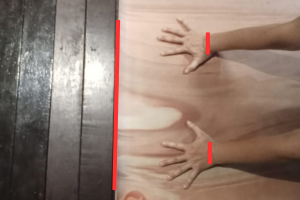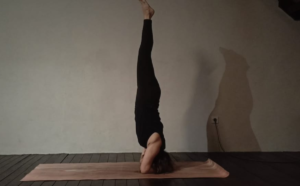Downward Facing Dog
Down Dog, formally known as Downward-Facing Dog (Adho Mukha Svanasana in Sanskrit), is one of the most fundamental yoga poses. In this posture, you plant both hands and feet on the mat, lift your hips toward the ceiling, and create a triangle shape with your body. This stretch resembles a dog waking up and stretching, helping to elongate the spine and reset the body.
A staple in nearly every yoga class, Down Dog often serves as a transition pose you return to multiple times during practice. Although it looks simple, it’s deceptively challenging and has profound effects on various parts of the body.
When I first started practicing yoga, I didn’t find this pose particularly comfortable—in fact, I found it quite difficult. But with time, I began to enjoy the process. In this post, I’ll share insights from my own journey, including how to approach Downward Dog, tips for alignment, and the benefits it can bring to your body and mind. My pose isn’t perfect either, so I hope you don’t mind that too much.
The Benefits of Down Dog
- Stretches the back of the thighs (hamstrings) and calves (gastrocnemius and soleus muscles). The entire back of the leg is stretched.
- As your arms are raised up, the latissimus dorsi is stretched.
- Down Dog is also a gentle inversion pose, as the head is lower than the heart. By promoting blood flow, circulation improves, which leads to increased metabolism, fatigue relief, and brain refreshment.
- Develops flexibility and strength in the arms and shoulders.
How to Do Down Dog
- Start on all fours. Start with your wrists under your shoulders and your knees directly under the hip joints.
Your feet should be about hip-width apart. However, this varies depending on the yoga style you practice. The width between your hands and feet can be adjusted slightly. - Point your toes and pull your hips diagonally backwards as you exhale.
- While paying attention to the shape of your hips and back, tilt your body diagonally from your pelvis. Contract the erector spinae muscles in your lower back to prevent your back from curving (straighten your spine). You can also bend your knees and raise your heels.
- If you can maintain the shape of your back, gradually straighten your knees while dropping your heels toward the floor. Squeeze the bases of your feet tightly to tilt your pelvis forward. Using the iliopsoas muscle will cause your pelvis to tilt forward.
Key Points to Remember
- Maintain the shape of your spine : Maintain the same upright posture when standing or sitting in Down Dog. At first, you won’t be able to bend your body forward from your pelvis, and your hips and back will tend to round. Try to maintain this position with your back straight, like when you’re standing or sitting.

- If your pelvis does not fall forward and your waist becomes rounded, at first just bend your knees, lift your heels off the floor, and pull your hips back to remove the roundness of your waist. Pull your hips back as far as you can and push your hips out to straighten your back. Don’t try to overextend your knees while the back of your thighs are still stiff. If you straighten your knees, your waist will definitely become rounded. As you gradually become able to maintain the shape of your back, bring your heels closer to the floor. This movement is a forward bend, as you are bending your body purely from the hip joints. In the case of down dog, once you set your body on all fours, the positions of your hands and feet are fixed, so the angle of your hip joints relative to your body is determined. You cannot keep your back straight unless you bend your knees and create some slack in the back of your thighs.



- Shoulder Shape : Your arms should be in a straight line that is an extension of your upper body. At first, your shoulders will inevitably stick out, so pull your hips back and tilt your pelvis, while pulling your shoulders back and stretching your arms up, aiming for a straight line from your upper body to your arms. If it’s difficult to raise both arms up, try as far as you can. If your shoulders are too tight, try to spread your hands a little wider than shoulder width and it will become easier to raise both arms.


- Rotate your shoulders outward into an external rotation. Start by reaching your arms forward with your palms facing up, allowing the entire shoulder joint to rotate externally. Since the palms need to face downward on the mat, rotate only the forearm (from the elbow down) inward so the palms face the floor, and then place your hands on the mat. Keep a comfortable amount of space between your shoulders and ears — avoid letting them get too close. Gently lower your shoulders away from your ears and maintain that space throughout the pose.
- Hand Placement : Align the creases of your wrists parallel to the front edge of the mat. Spread your fingers wide to maximize surface contact with the mat. Rather than having your middle fingers point directly forward, aim to have your index fingers pointing slightly forward instead.

- Elbow Alighment : The creases of your elbows should face each other. If the creases face forward, it could lead to hyperextension. Hyperextended elbows create instability in the joint, making it harder to support your body weight and potentially leading to strain or injury in the muscles or tendons of your elbows and wrists.
- Squeeze your pelvic floor, squeeze your lower abdomen. Breathe using your upper abdomen and whole chest.
- Remarks : Down dog that makes your chest curve : There is also a Down Dog in which the upper back is arched, stretching the shoulders. However, this type of Down Dog puts a lot of strain on the shoulders. The front and sides of the deltoids are easy to hurt. The shoulder joint itself is also easily strained.
- People who practice Pincha Mayurasana (Elbowstand) may bring their shoulders in, knowing the risks. To stretch the shoulders, the chest may be dropped in Down Dog. However, I personally think it is safer to first learn the neutral position with a straight back, and then practice Down Dog according to your purpose.

Why Maintain the Shape of Your Spine?
Because being conscious of maintaining the shape of your spine will have an effect on your hip joints. Rather than rounding your waist and relying on the weight of your upper body to drop your chest, you can get into the habit of actively contract the muscles at the base of your legs your hips and tilting your pelvis forward, which can be applied to inverted poses in the future. Even in the long term, you will likely feel changes in your body’s condition. As your range of motion gradually increases and you become able to perform the poses, the feeling of stretching will decrease, but you will be able to continue breathing comfortably.
Final Thoughts
Down Dog is performed many times in one class. If you continue to use your body incorrectly, it will gradually put strain on your body over the years. Even if you are okay now, you may hurt yourself in the next few years. I hope this article will be helpful for you to practice safely. Happy practice!


